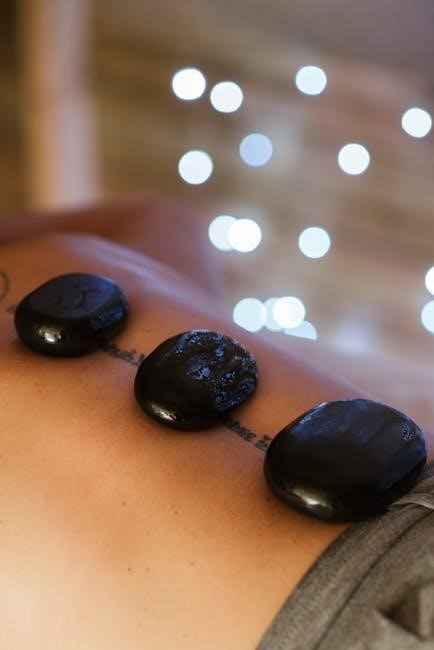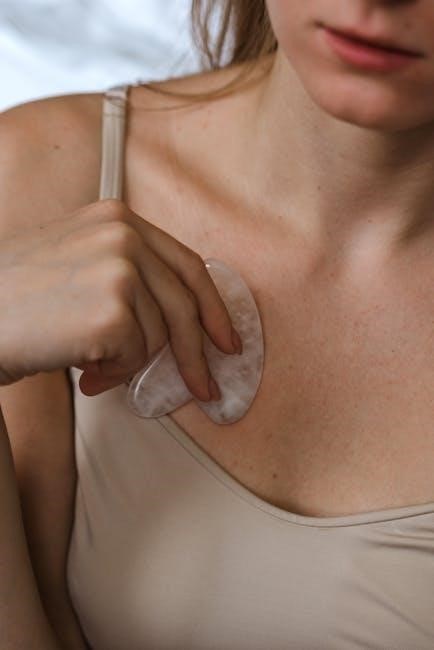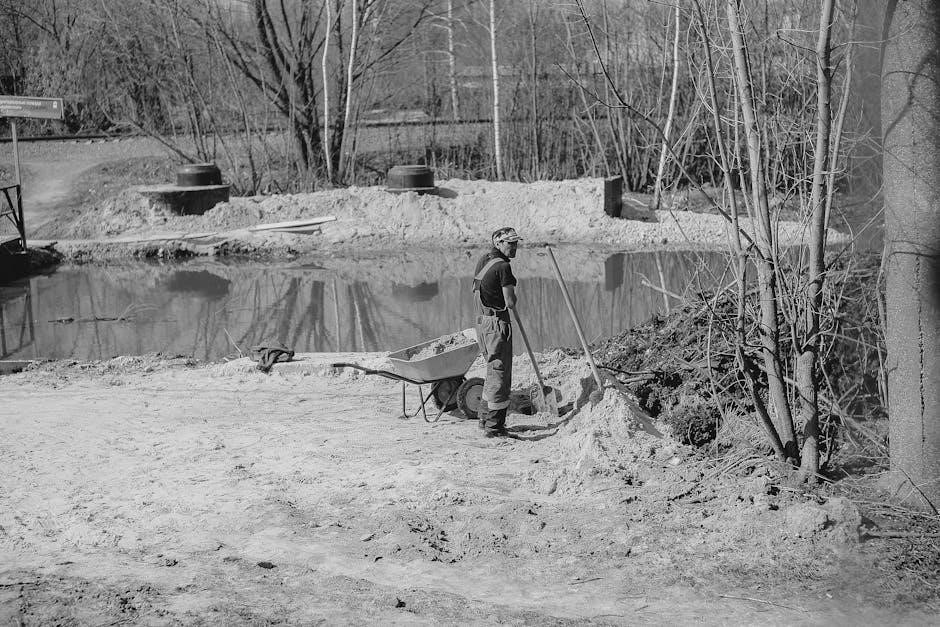Manual lymphatic drainage (MLD) is a gentle, non-invasive therapy targeting the lymphatic system to reduce swelling and promote fluid circulation. It is highly effective for lymphedema, post-surgery recovery, and detoxification, offering relief from fluid retention and enhancing overall well-being by stimulating lymph node function.
Definition and Purpose
Manual lymphatic drainage (MLD) is a specialized massage technique designed to stimulate the lymphatic system, enhancing the natural drainage of lymph fluid. It involves light, rhythmic strokes that guide lymph through the body, aiding in the removal of toxins and excess proteins. The primary purpose of MLD is to alleviate swelling, particularly in cases of lymphedema, which often occurs after surgery, cancer treatment, or trauma. By improving lymph circulation, MLD promotes healing, reduces inflammation, and enhances overall well-being. It is commonly used in medical and therapeutic settings to support post-surgical recovery, manage chronic swelling, and maintain immune function. MLD is gentle and non-invasive, making it suitable for individuals with sensitive conditions.
Overview of Benefits and Risks
Manual lymphatic drainage (MLD) is a therapeutic technique offering numerous benefits, primarily reducing swelling and promoting lymph fluid circulation. It alleviates lymphedema, enhances relaxation, and improves overall immune function. However, like any therapy, MLD carries risks, particularly if performed improperly. Incorrect techniques may worsen swelling or discomfort; Additionally, certain health conditions, such as active infections or severe circulatory issues, make MLD unsuitable. While generally safe, it is crucial to consult a trained therapist to avoid complications. Balancing its advantages and potential risks, MLD remains a valuable treatment for various health concerns when administered by a professional.

MLD is contraindicated in conditions like active cancer, severe circulatory issues, or acute infections, as it may worsen symptoms or spread disease. Professional consultation is essential.
Medical Conditions That Prohibit MLD
Certain medical conditions, such as active cancer, severe circulatory issues, or acute infections, prohibit the use of manual lymphatic drainage (MLD). Active cancer or metastasis can spread disease, while severe circulatory problems may worsen with MLD. Acute infections or inflammatory diseases, like cellulitis, should avoid MLD to prevent exacerbating symptoms. Additionally, conditions causing severe swelling or inflammation require caution, as MLD may not be suitable during acute phases. Always consult a healthcare professional before undergoing MLD, especially with pre-existing medical conditions, to ensure safe and effective treatment. Proper assessment is crucial to avoid complications and ensure the therapy benefits the individual without risking further health issues. Professional guidance is essential in such cases.
Acute Infections and Inflammatory Diseases
Acute infections and inflammatory diseases are significant contraindications for manual lymphatic drainage (MLD). Conditions such as cellulitis, erysipelas, or other active infections can worsen with MLD, as the therapy may spread infection or delay healing. Inflammatory diseases in their acute phase, like acute arthritis or severe dermatitis, should also be avoided, as MLD could exacerbate inflammation. It is crucial to wait until these conditions are properly managed and resolved before considering MLD. Always consult a healthcare professional to ensure the infection or inflammation is under control. MLD is not recommended during active flare-ups, as it may interfere with the body’s natural healing process or worsen symptoms. Professional medical evaluation is essential to determine the appropriate timing for MLD in such cases.

Specific Health Situations to Avoid MLD
Active cancer, severe circulatory issues, and certain infections require caution. MLD should not be performed during acute inflammatory phases or when allergies are severe, as risks may outweigh benefits.
Active Cancer Diagnosis or Metastasis
Manual lymphatic drainage (MLD) is contraindicated during an active cancer diagnosis or metastasis, as it may inadvertently dislodge cancer cells, potentially spreading them through the lymphatic system. While MLD can be beneficial for lymphedema management in cancer survivors, it must be avoided in cases where cancer is active or metastasizing. This precaution is critical to prevent exacerbating the condition or complicating treatment. However, in some cases, MLD may be performed under strict medical supervision if deemed necessary. Always consult with a healthcare provider before considering MLD in such scenarios to ensure safe and appropriate care.
Severe Circulatory Issues and Heart Conditions
Manual lymphatic drainage (MLD) is contraindicated in individuals with severe circulatory issues or heart conditions. Conditions such as heart failure, severe edema, or circulatory insufficiency may worsen with MLD, as it can further disrupt blood flow and fluid balance. Additionally, MLD should be avoided in cases of acute venous thrombosis or severe varicose veins, as the manipulation of lymphatic vessels could dislodge blood clots or exacerbate venous pressure. Patients with these conditions require specialized medical care, and MLD could pose significant risks to their health. Always consult a healthcare provider before considering MLD in such circumstances to ensure safe and appropriate treatment.

Acute Injuries and Inflammation
MLD is contraindicated in acute injuries or inflammation, as it may exacerbate swelling or disrupt the healing process, potentially worsening the condition or causing further damage.
Recent Trauma or Surgery
Manual lymphatic drainage (MLD) is generally contraindicated in cases of recent trauma or surgery, as it may interfere with the body’s natural healing processes. Applying MLD too soon after an injury or surgical procedure can exacerbate swelling, disrupt scar tissue formation, or even reopen wounds. Additionally, manipulating the lymphatic system in such scenarios may dislodge blood clots or introduce infection, leading to further complications. Patients should typically wait until the acute phase of healing has passed and receive clearance from their healthcare provider before undergoing MLD. This ensures that the therapy is applied safely and effectively, avoiding potential setbacks in recovery.
It is crucial to approach MLD with caution following any invasive medical procedure or physical trauma, as the timing and technique must be carefully tailored to the individual’s condition. Rushing into lymphatic drainage without proper assessment can negate its benefits and pose unnecessary risks to the patient’s health.
Acute Swelling or Inflammation
Manual lymphatic drainage (MLD) is contraindicated in cases of acute swelling or inflammation, as it may exacerbate the condition. During acute phases, the lymphatic system is already overwhelmed, and applying MLD could push excess fluid into compromised areas, worsening swelling. Additionally, inflamed tissues are highly sensitive, and manipulating them through MLD may cause discomfort or further irritation. It is essential to allow the inflammation to subside and the condition to stabilize before considering MLD. A healthcare provider or trained therapist should assess the situation to determine the appropriate timing for safely initiating lymphatic drainage. This ensures the therapy is effective and does not hinder the body’s natural healing processes.
Acute swelling often requires rest, elevation, and other supportive measures before MLD can be safely applied. Rushing into lymphatic drainage during this phase may lead to unintended consequences, such as increased fluid retention or prolonged recovery times. Patience and careful timing are critical to maximize the benefits of MLD while minimizing potential risks.

Other Factors to Consider
Other factors include pregnancy, severe allergic reactions, or skin conditions, which require specialized care and consultation with a healthcare provider to avoid complications during MLD.
Pregnancy and Specific Medical Conditions
Pregnancy and certain medical conditions require careful consideration before undergoing MLD. While MLD is generally safe, pregnant women should consult their healthcare provider to ensure it is appropriate, as the body undergoes significant changes. Specific medical conditions, such as severe circulatory issues or active cancer, may also contraindicate MLD. Patients with a history of blood clots, deep vein thrombosis, or severe heart conditions should avoid this therapy. Additionally, individuals with compromised immune systems or those undergoing chemotherapy or radiation therapy should seek medical advice. MLD is not recommended for acute medical conditions, as it may exacerbate symptoms or interfere with treatment. Always prioritize a personalized approach to ensure safety and effectiveness.
Severe Allergic Reactions or Skin Conditions
Severe allergic reactions or certain skin conditions may contraindicate manual lymphatic drainage (MLD). Conditions like eczema, psoriasis, or acute skin infections can worsen with manual therapy. MLD involves gentle manipulation of the skin, which may irritate sensitive areas or spread infection. Allergic reactions, especially those involving the skin, require caution. If a patient has a history of severe allergies, particularly to massage oils or lotions, alternative methods should be considered. Additionally, active skin conditions like rosacea or open wounds make MLD inadvisable. Always consult a healthcare provider to assess suitability and avoid exacerbating pre-existing conditions. Personalized care is essential to ensure safety and effectiveness.
